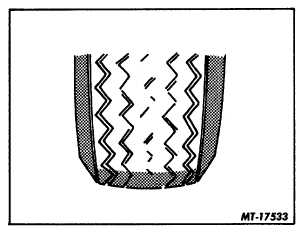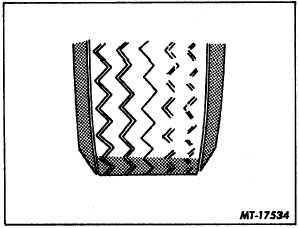|
| |
TRUCK SERVICE MANUAL
TM 5-4210-230-14&P-1
WHEELS, RIMS, TIRES
CHAPTER 2 - TIRES AND TUBES
GENERAL
Proper maintenance and careful driving will result in
maximum tire life. When a tire is properly inflated it will
provide maximum traction, resist damage from road shock,
tires will run cooler and "squirm" less than at a lower
pressure. A tire properly inflated can be injured when a chuck
hole, curb or other object is struck with sufficient force. When
driving on a rough surface road slow down. Tread wear can
be shortened by driving habits such as, sudden stops,
excessive use of brakes, driving at excessive speeds, and
riding on edge of pavement.
Air pressure is what enables tires to support a load
and proper inflation is essential for maximum tire life. Refer
to the vehicles operator manual or tire manufacturer's inflation
chart for proper air pressure. Remember that the
recommended pressures are cool tire pressure. Check air
pressure before driving or after tires have a chance to cool.
"Bleeding" air from hot tires should never be
practiced. The pressure will be reduced, but an increase in
temperature and pressure will result as soon as driving
continues.
TREAD WEAR PATTERNS
Underinflation:
The abnormal wear of the treads as shown in Fig. 12
is due to underinflation. Increase air pressure to the
recommended level. Never exceed maximum tire pressure.
Fig. 12 Underinflation Causes Excessive Side Tread Wear
Overinflation:
Excessive wear in the center of the tread is due to
overinflation, Fig. 13. Never "bleed" air from hot tires. The
pressure will be reduced but an increase in temperature will
result as soon as driving continues.
Fig. 13 Overinflation, Excessive Wear in Center of Tread
Fast Cornering:
Fast cornering causes tires to wear more on the
shoulders of the tread as shown in Fig. 14. Slow down before
negotiating curves or corners.
Fig. 14 Fast Cornering Results in Excessive Wear on
Shoulders of Tread
CTS-2167N Page 7
PRINTED IN UNITED STATES OF AMERICA
|



